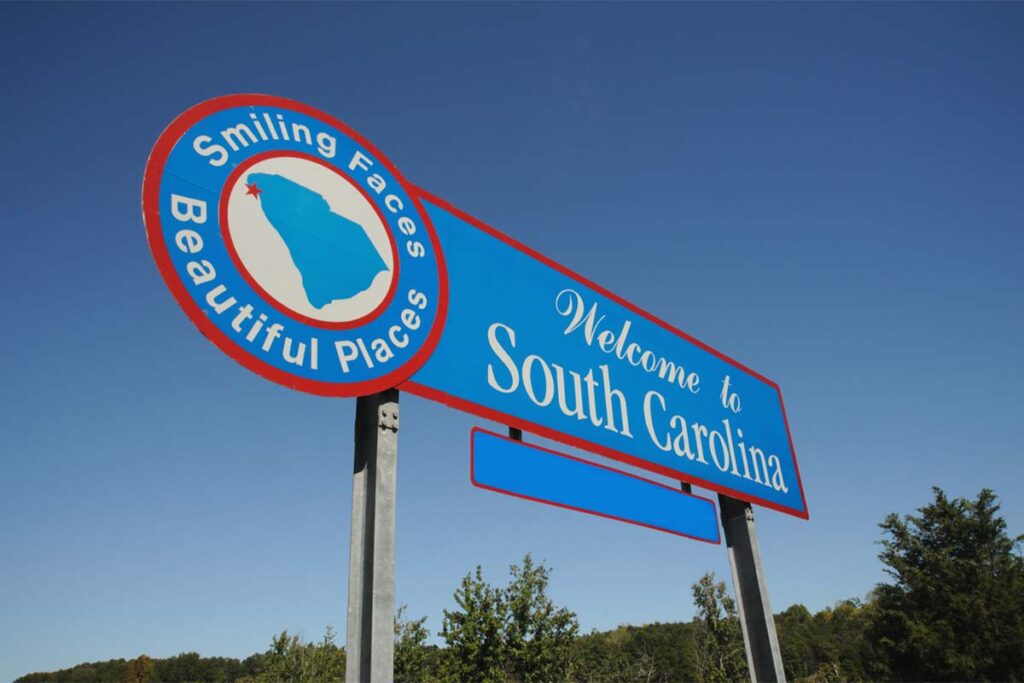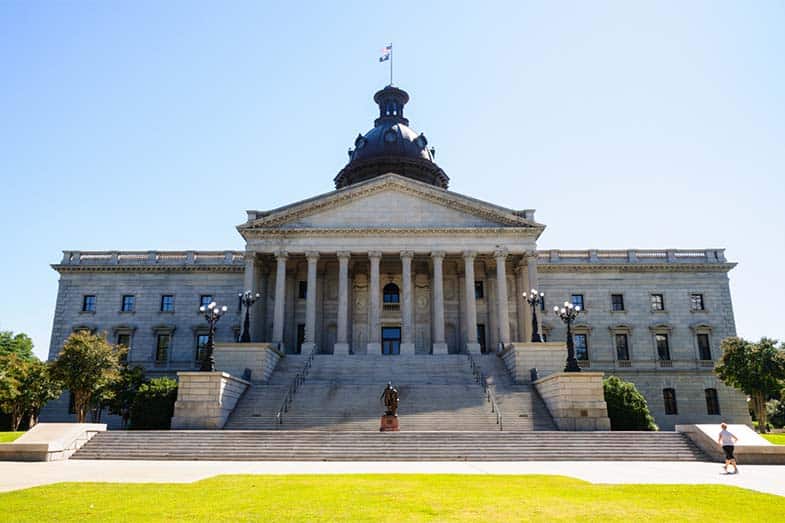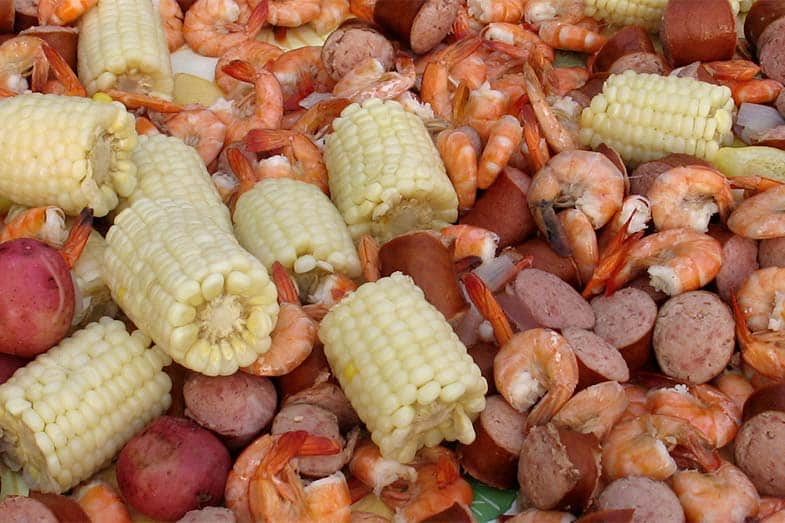South Carolina, the Palmetto State, is the 40th largest American state and has the 23rd largest population in the country. It is a southeastern state best renowned for its historical districts, golf courses, food, hospitality, and more. Learn more about what South Carolina is known for in this guide.
More than its golf courses, laid-back English lifestyle, and participation in the American Revolution, South Carolina is also known for its massive plantations, tourist attractions, well-protected ecosystems, and produce. The Tastier Peach State thrives on agriculture and is passionate about protecting wildlife.
Here are 15 things South Carolina is most known for:
- South Carolina became a state in 1788.
- The state name comes from the Latin word Carolus.
- Its nickname comes from its large population of Palmetto trees.
- It houses the only large-scale commercial tea plantation in the U.S.
- The first U.S. golf course was established in 1786 on Harleston Green.
- It is home to some of the most remarkable celebrities in U.S. history.
- South Carolina is fondly referred to as “The Tastier Peach State.”
- Restoration of the SC State House took 38 years in the making.
- The city limits of Charleston hold some of the country’s oldest flora.
- Fort Mill, SC, continues to breed the world’s hottest pepper.
- Its version of The Sky is found in Capstone Building in Columbia.
- The region is a haven for nature lovers and adventurers.
- Like Alaska and Hawaii, SC does not have any pro sports team.
- It is a place full of the spiritual, the mysterious, and of firsts.
- SC boasts a unique cuisine with strong Gullah-Caribbean influences.
In truth, I cannot even begin to sum up all of South Carolina’s perks. Research reveals tons of information about the state, its different districts, and how its offerings are both distinct and cohesive. With its huge British, African, and Caribbean influences, there is definitely more to enjoy in the land of barbecue and sweet tea – so stick around and discover them all in this article.
15 Fun Facts About South Carolina

1. South Carolina became a state in 1788.
South Carolina is one of the original thirteen (13) American colonies where the English settled in the 1500s. Expectedly, it is also among the earliest states to ratify the U.S. Constitution – on May 23, 1788, just 69 years after it became a royal British colony. Its participation in opposing Great Britain and other states that formed part of the Southern Colonies led to the fruition of an independent United States of America.
2. The state name comes from the Latin word Carolus.
Like most significant former British colonies, South Carolina is named after a monarch. At the time, it was King Charles II on the throne when the eight noblemen known as the Lord’s Proprietors were given a charter/joint ownership of tracts of land in the New World (a.k.a. Carolina). While the rights to these lands ended in 1729 when George II took over as King, South Carolina and the other colonies retained their names after earning their independence from England.
3. Its nickname comes from its large population of Palmetto trees.
Palmetto trees (otherwise known as sabal palmetto, cabbage palmetto, or Inodes Palmetto) are the origin of South Carolina’s official nickname. While the state has been referred to using this moniker for a while, it was not until 1861 – when SC formally seceded from the Union – that the symbol for a palmetto tree was adapted into the official state flag.
Not only is the palmetto tree a fitting representation of South Carolina’s subtropical climate, but it also is an icon that played a significant role during the American Revolutionary War. It was said that cannonballs fired by the British Army bounced off Fort Moultrie’s exterior walls, which were then made of spongy palmetto logs.
4. It houses the only large-scale commercial tea plantation in the U.S.
While there are a total of 15 American states with 60 farms comprising the growing U.S. tea movement (based on a 2017 report by www.npr.org), the plantation located on the high-elevation foothills of Wadmalaw Island near Charleston SC is the only place where “Uniquely American Tea(TM)” is produced and cultivated. Tea from these parts of the U.S. descend from tea bushes first brought to South Carolina in the early 1700s.
5. The first U.S. golf course was established in 1786 on Harleston Green.
Charleston is known for being named after King Charles I and II of England and for nestling the first-ever gold club in American history. As early as 1743, the oldest city in South Carolina has been welcoming shipments of golf balls and clubs from Scotland. Expectedly, the city’s support of the said trade led to forming the South Carolina Golf Club on September 29, 1786.
Within the same year, America’s first golf course was established on Harleston Green Park, situated between Calhoun and Beaufain streets stretching from Rutledge Avenue to the Ashley River. The city’s deeply rooted love for golf continues to enamor enthusiasts, tourists, and even permanent residents. At present, the entire state has over 350 golf courses for hobbyists and aficionados to choose from, with Myrtle Beach competing with Naples, Florida as the “Golf Capital of the World.”
6. It is home to some of the most remarkable celebrities in U.S. history.
“Godfather of Soul” James Brown, Noble Prize winner Charles H. Townes (Physics), Wimbledon champ Althea Gibson, long-serving former U.S. Senator Strom Thurmond, and pro boxing legend Joe Frazier all hail from this great state in the south.
7. South Carolina is fondly referred to as “The Tastier Peach State.”
While many Americans are conflicted between Georgia and South Carolina as the main producer of U.S.-grown peaches, California takes the lead in fresh peach production. But since Cali’s official fruit is already avocado, the battle for peach supremacy is left to the other two.
Declaration-wise, South Carolina named peaches (Prunus persica) as its state fruit 11 years earlier than Georgia did, through Act No. 360 of 1984. Plus, SC boasts a longer track record in peach production – commercially growing over 30 varieties since the 1860s. Don’t worry – there is no real animosity between these two magnificent states. It is just amusing how friendly competition can get people worked up about their official produce – calling Georgia “The Peach State” and SC “The Tastier Peach State.”
8. Restoration of the SC State House took 38 years in the making.
Because the controversial burning of the statehouse in Columbia on February 17, 1865, received a lot of attention at one point, people would have thought it only took an instant to restore such a significant place. Unfortunately, the American Revolutionary War left affected U.S. regions an enormous dent in funding that it took almost four (4) decades after the incident before the charred statehouse was fixed.

9. The city limits of Charleston hold some of the country’s oldest flora.
The limbs of the 1,500-year-old Angel Oak (Quercus virginiana) — one of America’s oldest living trees — sprawl right outside the city of Charleston, on the beautiful Johns Island. This picturesque live oak, alongside other flora, is undoubtedly one of the most stunning sights to see when spending the holidays in good ‘ol Charleston. The Magnolia Plantation and Great Colonial Garden are definitely worth checking out, too, if you prefer landscaped greenery and dreamy hues.
10. Fort Mill, SC, continues to breed the world’s hottest pepper.
No other pepper has beaten the Carolina Reaper in SHU or Scoville Heat Units rating. The undisputed, 8-year old record holder (produced in “Smokin” Ed Currie’s greenhouse in Fort Mill) is a cross between red habanero peppers and ghost peppers and peaks over 2.2M on the Scoville Scale. Unofficially, however, it is said that Ed’s more-recent Dragon’s Breath (2.48M SHU) and Pepper X (3.18M SHU) have taken over the former’s title.
11. Its version of The Sky is found in Capstone Building in Columbia.
Sitting on top of the 18-story Capstone Building in Columbia, The Top restaurant is the only revolving restaurant in South Carolina. It offers stunning views of the Columbia landscape. There is no other perfect place to savor delectable southern food and the city’s amazing skyline unorthodox style.
12. The region is a haven for nature lovers and adventurers.
That’s right — South Carolina is not just a golfer’s paradise. There are tons of attractions in the Peach State that cater to different hobbyists. People who love the outdoors, in general, will appreciate the many options the state has to offer. Middleton Place, Myrtle and Coligny Beaches, Joe Riley Waterfront Park, and the Arthur Ravenel Jr. Bridge are scenic and historic sites vacationers are guaranteed to enjoy. Meanwhile, the Hilton Head Island Bike Trails and the curved Liberty Bridge in Falls Park, Greenville, will provide some thrills.
13. Like Alaska and Hawaii, SC does not have any pro sports team.
In case you were wondering, South Carolina does not have representation in the NFL (National Football League), MLB (Major League Baseball), NBA (National Basketball Association), and NHL (National Hockey League). But the Southern state is not alone — 23 other contiguous states join it in this category. This is not to say that SC lacks star athletes. Some of the U.S.’s greatest sports figures hailed from the Palmetto State.
14. It is a place full of the spiritual, the mysterious, and of firsts.
God’s Acre Healing Spring in Blackwell is a must-see site in the state and has made headlines for its rumored healing waters capable of curing the wounded and sick. The water from the Catfish Creek may not be as famous but (according to folklore) is also mystic and gets those who drink it to want to stay forever in Marion County. There are also human-made mysteries like the “mystery tree” on Edisto Island — a hodge-podge of strange, random items hanging from a log.
As for firsts, South Carolina was the first American state to secede from the Union and to have a public college, museum, and playhouse. It is also the birthplace of the first-ever U.S. senator elected via a write-in vote (a total of 139,106 votes for Senator Thurmond in 1954). All in all, these wonders and its rich history (among other things) make South Carolina more interesting.
15. SC boasts a unique cuisine with strong Gullah-Caribbean influences.
Here are some top choices in case you are wondering what food is South Carolina known for:
Oyster Roast
The Oyster Roast is a delicacy characteristic of South Carolina and an emblem of the state that only comes second to the Sabal Palmetto in popularity. Originally hosted for visiting sailors in the early 1900s, it now signifies the strong Carolinian community and the bounty of the sea. Apart from agriculture, SC is also known for its excellent oyster industry well-celebrated through festivals, fundraisers, and other fun but meaningful events.
Beaufort’s Stew (a.k.a. Frogmore Stew, Tidewater Boil, or Lowcountry Boil)
Despite the moniker, this traditional Carolinian dish does not involve cooked frogs. To add, it is not a stew but a mix of delicious boiled ingredients – shrimp, sausages, crabs or crawfish, freshly-shucked yellow corn, and red-skin potatoes – dumped on a table covered with brown bag paper or newspaper and enjoyed the boodle-fight style. This dish originated from a small fishing community on Frogmore near Hilton Head and Beaufort – hence, the moniker.

Whole-Hog Barbecue
Before this method of cooking meat reached South Carolina and became a trademark of the state, barbecuing or barbacoa (covering meat with basting sauce and spices and cooking it over a pit or grill) was first done by the Taino Indian tribe in the Caribbean. Originally, the term barbacoa did not refer to a cooking method but pertained to a raised wooden grate where the Taino Indians smoked their food.
Boiled Peanuts
Modest, salty, and toothsome, SC’s official state snack has a large (and somewhat bittersweet) African influence. The act of boiling peanuts was first brought to the U.S. by African slaves. South Carolina, at one point, had two-thirds of its population consist of these field workers who tilled the lands and helped with harvesting various kinds of crops. Whenever there was a surplus, these same African slaves boiled the excess peanuts and shared the snack among themselves, alongside simple food and friendly conversation.
Huguenot Torte (a.k.a. Ozark Pudding)
One of South Carolina’s signature desserts and a favorite in tearooms, you are sure to find this delicious torte in all restaurants in the Charleston area. This wonderfully baked apple-and-nut torte is comparable to a pecan pie without the crust. Do not be fooled by the name — this iconic dessert has little (if not nothing) to do with the French protestants who left their homeland for the Peach State.
Lady Baltimore Cake
This specialty cake is an iconic southern dessert that has become a favorite in weddings due to its complex, unique flavors. It includes white sponge cake and marshmallowy divinity frosting. While the composition of the base cake has remained unchanged over the years, many bakers put their own spin on it with the toppings — the most common of which are either coconut shavings, pecans, raisins, or candied cherries. Legend has it that a southern lady named Alicia Rhett Mayberry served this cake to novelist Owen Wister. He reportedly used the cake as the namesake for one of his romance novels.
Chicken Bog
A dish most popular in Horry County (where you find Conway and the highly-acclaimed Myrtle Beach), Chicken Bog consists of fall-off-the-bone chicken, rice, and smoked sausage cooked in chicken stock. It is great comfort food that hits the spot during cold weather and can be cooked creamy or Cajun-style. The closest thing to this one-pot rice dish is a chicken-and-rice pilaf. Other than that, its taste profile is distinctly South Carolinian.
Sweet Tea
A staple in locations with scorching summers, this thirst-quenching southern concoction everyone has grown to love originated from Summerville, South Carolina.
Conclusion – Facts About South Carolina
So, what is South Carolina famous for? Again, here is the list to help you remember:
- South Carolina became a state in 1788.
- The state name comes from the Latin word Carolus.
- Its nickname comes from its large population of Palmetto trees.
- It houses the only large-scale commercial tea plantation in the U.S.
- The first U.S. golf course was established in 1786 on Harleston Green.
- It is home to some of the most remarkable celebrities in U.S. history.
- South Carolina is fondly referred to as “The Tastier Peach State.”
- Restoration of the SC State House took 38 years in the making.
- The city limits of Charleston hold some of the country’s oldest flora.
- Fort Mill, SC, continues to breed the world’s hottest pepper.
- Its version of The Sky is found in Capstone Building in Columbia.
- The region is a haven for nature lovers and adventurers.
- Like Alaska and Hawaii, SC does not have any pro sports team.
- It is a place full of the spiritual, the mysterious, and of firsts.
- SC boasts a unique cuisine with strong Gullah-Caribbean influences.
Whether it be immaculate sceneries, uniquely flavorful food, or proof of history that you are looking for, South Carolina has it all! The fifteen fun facts listed in this guide may not be exhaustive. They will get you hooked to this part of the U.S., no matter where you go in SC, including historic Charleston, enchanting Johns Island, or busy Myrtle Beach. You are sure to have genuinely unforgettable memories and an overall incredible experience.
